Convergence of topological domain boundaries, insulators, and polytene interbands revealed by high-resolution mapping of chromatin contacts in the early Drosophila melanogaster embryo
- PMID: 29148971
- PMCID: PMC5739541
- DOI: 10.7554/eLife.29550
Convergence of topological domain boundaries, insulators, and polytene interbands revealed by high-resolution mapping of chromatin contacts in the early Drosophila melanogaster embryo
Abstract
High-throughput assays of three-dimensional interactions of chromosomes have shed considerable light on the structure of animal chromatin. Despite this progress, the precise physical nature of observed structures and the forces that govern their establishment remain poorly understood. Here we present high resolution Hi-C data from early Drosophila embryos. We demonstrate that boundaries between topological domains of various sizes map to DNA elements that resemble classical insulator elements: short genomic regions sensitive to DNase digestion that are strongly bound by known insulator proteins and are frequently located between divergent promoters. Further, we show a striking correspondence between these elements and the locations of mapped polytene interband regions. We believe it is likely this relationship between insulators, topological boundaries, and polytene interbands extends across the genome, and we therefore propose a model in which decompaction of boundary-insulator-interband regions drives the organization of interphase chromosomes by creating stable physical separation between adjacent domains.
Keywords: D. melanogaster; Hi-C; ZGA; chromatin topology; chromosomes; evolutionary biology; gene regulation; genes; genomics; insulator; polytene.
Conflict of interest statement
No competing interests declared.
Figures

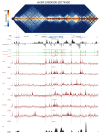


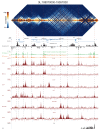

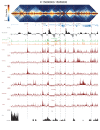





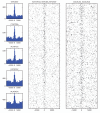
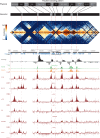

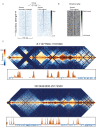















Similar articles
-
Banding Pattern of Polytene Chromosomes as a Representation of Universal Principles of Chromatin Organization into Topological Domains.Biochemistry (Mosc). 2018 Apr;83(4):338-349. doi: 10.1134/S0006297918040053. Biochemistry (Mosc). 2018. PMID: 29626921 Review.
-
[Chromomeric organization of interphase chromosomes in Drosophila melanogaster].Tsitologiia. 2013;55(3):144-7. Tsitologiia. 2013. PMID: 23795454 Review. Russian.
-
High-resolution in situ hybridization analysis on the chromosomal interval 61C7-61C8 of Drosophila melanogaster reveals interbands as open chromatin domains.Chromosoma. 2016 Jun;125(3):423-35. doi: 10.1007/s00412-015-0554-5. Epub 2015 Oct 31. Chromosoma. 2016. PMID: 26520107
-
Genes Containing Long Introns Occupy Series of Bands and Interbands In Drosophila melanogaster polytene Chromosomes.Genes (Basel). 2020 Apr 11;11(4):417. doi: 10.3390/genes11040417. Genes (Basel). 2020. PMID: 32290448 Free PMC article.
-
Genetic organization of interphase chromosome bands and interbands in Drosophila melanogaster.PLoS One. 2014 Jul 29;9(7):e101631. doi: 10.1371/journal.pone.0101631. eCollection 2014. PLoS One. 2014. PMID: 25072930 Free PMC article.
Cited by
-
Super-resolution microscopy reveals stochastic initiation of replication in Drosophila polytene chromosomes.Chromosome Res. 2022 Dec;30(4):361-383. doi: 10.1007/s10577-021-09679-w. Epub 2022 Feb 28. Chromosome Res. 2022. PMID: 35226231 Free PMC article.
-
Application of the 3C Method to Study the Developmental Genes in Drosophila Larvae.Front Genet. 2022 Jul 15;13:734208. doi: 10.3389/fgene.2022.734208. eCollection 2022. Front Genet. 2022. PMID: 35910225 Free PMC article.
-
Chromatin architecture reorganization during neuronal cell differentiation in Drosophila genome.Genome Res. 2019 Apr;29(4):613-625. doi: 10.1101/gr.246710.118. Epub 2019 Feb 1. Genome Res. 2019. PMID: 30709849 Free PMC article.
-
Chromatin dynamics at the maternal to zygotic transition: recent advances from the zebrafish model.F1000Res. 2020 Apr 28;9:F1000 Faculty Rev-299. doi: 10.12688/f1000research.21809.1. eCollection 2020. F1000Res. 2020. PMID: 32528656 Free PMC article. Review.
-
Precisely timed regulation of enhancer activity defines the binary expression pattern of Fushi tarazu in the Drosophila embryo.Curr Biol. 2023 Jul 24;33(14):2839-2850.e7. doi: 10.1016/j.cub.2023.04.005. Epub 2023 Apr 27. Curr Biol. 2023. PMID: 37116484 Free PMC article.
References
-
- Balbiani EG. Sur La Structure Du Noyau Des Cellules Salivares Chez Les Larves de Chironomus. Zoologischer Anzeiger. 1881;4:637662–641666.
-
- Balbiani EG. Sur La Structure Intime Du Noyau Du Loxophyllum Meleagris. Zoologischer Anzeiger. 1890;13:110, 132–15.
-
- Beagrie RA, Scialdone A, Schueler M, Kraemer DC, Chotalia M, Xie SQ, Barbieri M, de Santiago I, Lavitas LM, Branco MR, Fraser J, Dostie J, Game L, Dillon N, Edwards PA, Nicodemi M, Pombo A. Complex multi-enhancer contacts captured by genome architecture mapping. Nature. 2017;543:519–524. doi: 10.1038/nature21411. - DOI - PMC - PubMed
Publication types
MeSH terms
Substances
Grants and funding
LinkOut - more resources
Full Text Sources
Other Literature Sources
Molecular Biology Databases

